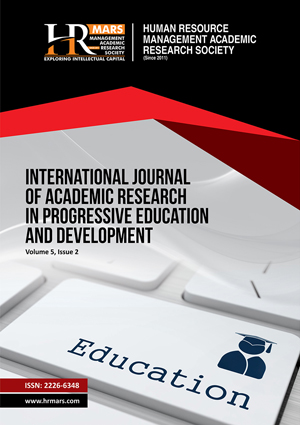
ISSN: 2226-6348
Open access
The incidence of Autism Spectrum Disorder (ASD) continues to rise globally, with epidemiological studies reporting a prevalence rate as high as 1 in 54. Theory of Mind (ToM), defined as the ability to infer and predict others' mental states and behaviors, is widely regarded as a core deficit underlying social communication challenges in children with autism. This study employs a quantitative comparative research design to investigate differences in ToM development between 30 children with ASD (experimental group, aged 6–8) and 30 age-matched typically developing children (control group). Results demonstrate that children with ASD exhibited significantly lower levels of ToM development compared to their typically developing peers, with marked difficulties observed in tasks assessing basic belief understanding and false belief reasoning.
World Health Organization. (2023). Autism spectrum disorder. Retrieved March 12, 2025, from https://www.who.int/publications
Babytree Public Welfare Team. (2021). Zhongguo zibizheng jiating qingkuang diaoyan baipishu. Retrieved March 12, 2025, from https://www.babytree.com/whitepaper
Ma, Y. Q., & Hu, X. Y. (2020). A review of research on theory of mind teaching for children with autism. Modern Special Education, 18, p. 7.
Baron-Cohen, S., Leslie, A. M., & Frith, U. (1985). Does the autistic child have a “theory of mind?” Cognition, 21, 27-43.
Yirmiya, N., Erel, O., Shaked, M., & Solomonica-Levi, D. (1998). Meta-analyses comparing Theory of Mind abilities of individuals with autism, individuals with mental retardation, and normally developing individuals. Psychological Bulletin, 124, 283-307.
Baron-Cohen, S., Tager-Flusberg, H., & Cohen, D. J. (2000). Understanding other minds: Perspectives from developmental cognitive neuroscience. Oxford: Oxford University Press.
American Psychiatric Association. (2013). Diagnostic and statistical manual of mental disorders (5th ed.). Arlington, VA: American Psychiatric Publishing.
Baron-Cohen, S. (2001). Theory of mind in normal development and autism. Prisme, 34(1), 74–183.
Wellman, H. M., Cross, D., & Watson, J. (2003). Meta-analysis of theory-of-mind development: The truth about false belief. Child Development, 72(3), 655–684.
Bartsch, K., & Wellman, H. M. (1995). Children talk about the mind. Oxford University Press.
Flagella, J. H. (1986). The development of children's knowledge about the appearance-reality distinction. American Psychologist, 41(4), 418.
Rutter, M. (2005). Aetiology of autism: Findings and questions. Journal of Intellectual Disability Research, 49(4), 231–238.
Ratajczak, H. V. (2011). Theoretical aspects of autism: Causes—A review. Journal of Immunological, 8(1), 68–79.
Premack, D., & Woodruff, G. (1978). Does the chimpanzee have a theory of mind? The Behavioral and Brain Sciences, 1(4), 515–526.
Schuwerk, T., Jarvers, I., Vuori, M. (2016). Implicit mentalizing persists beyond early childhood and is profoundly impaired in children with autism spectrum condition. Frontiers in Psychology, 7, 1696.
Heyes, C. M., & Frith, C. D. (2014). The cultural evolution of mind reading. Science, 344(6190), 1243091.
Booules-Katri, T., Pedreño, C., Navarro, J. (2019). Theory of Mind (ToM) Performance in High Functioning Autism (HFA) and Schizotypal-Schizoid Personality Disorders (SSPD) Patients. Journal of Autism and Developmental Disorders, 49(8), 3376–3386.
Baron-Cohen, S., Leslie, A. M., & Frith, U. (1985). Does the autistic child have a “theory of mind”? Cognition, 21(1), 37–46.
Lu, X., Tian, L., Zhang, J. (2021). An overview and development trends of the comprehensive intervention model for autism in the United States. Chinese Special Education, (10), 44–51.
Qin, M. P., Ren, G. Q., Du, Z. M. (2020). Research progress on theory of mind in individuals with autism spectrum disorder. Chinese Special Education, (02), 49–56.
Gu, X. H., & Zheng, P. Y. (2021). Analysis of the causes of theory of mind deficits in individuals with autism: Abnormal information processing. Chinese Special Education, (06), 75–81.
Yan, Z. Q., Lin, Y. Q., & Zhu, H. M. (2020). Understanding autism spectrum disorder: Perspectives from neurodiversity and reflections. Modern Special Education, (10), 44–50.
Zhou, J. (2017). A study on family functioning and its influencing factors in children with autism spectrum disorder. Liaoning Normal University.
Li, G. R., & Yu, S. T. (2004). A review of research trends in the diagnosis and treatment of autism. Psychological Science, (06), 1449–1450+1448.
Zhang, T., Cao, M. J., Mei, J. J., Xu, W. S., Shi, P. J., & Liu, S. J. (2021). Research status on the manifestations, causes, and intervention methods of autism spectrum disorder. Journal of Baotou Medical College, (11), 117–12
Xiuli, W., Hussain, Y. B., Zinan, W., & Kamarudin, D. (2025). A Study of 6-8 Years Old Autism Children’s Theory of Mind Developmental Characters. International Journal of Academic Research in Progressive Education and Development, 14(1), 2282–2294.
Copyright: © 2025 The Author(s)
Published by HRMARS (www.hrmars.com)
This article is published under the Creative Commons Attribution (CC BY 4.0) license. Anyone may reproduce, distribute, translate and create derivative works of this article (for both commercial and non-commercial purposes), subject to full attribution to the original publication and authors. The full terms of this license may be seen at: http://creativecommons.org/licences/by/4.0/legalcode